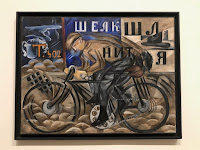Natalia Goncharova
Stunning exhibition at Tate Modern on the life and work of the Russian artist Natalia
Goncharova.
The show was
wonderfully colourful and included paintings, textile designs, book
illustrations and theatrical designs. It chartered her work from rural Imperial
Russia to her life in Paris after the 1920s.
I loved the early
work and it was a nice touch to show it with a peasants outfit of the time to
show you where the colours and vibrancy came from. She showed an interest in
textiles throughout her life and in fact the name of her family estate meant
“cloth factory” and a number of the pictures in this section looked at the
process of cloth making.
The show looked
at how Moscow, where Goncharova moved when she was eleven, was one of the best
places in the world to see modern part as two industrialists, Ivan Morozov and
Sergie Shchukin, had huge collections which they opened to the public and there
was a room of pictures Goncharova would have seen there plus works they
purchases from her.
This was followed
by a room recreated her 1913 exhibition bringing together 33 works which would
have been seen there. It showed a range of styles that she was trying including
the seven remaining pieces of the nine piece work “Harvest”. The whole room had
a real sense of joy and exuberance.
It was nice to
have a room of her religious works including “The Evangelists” which was shown
in London in the 1912 Post-Impressionist exhibition. Also a corridor of book
illustrations and archive material.
I loved the
cyclist shown here which was in the room on Modernism. I loved the sense of
movement in it and the use of words and lettering. From 1912-13 Goncharova
started looking at more urban subjects and she started to look at abstract
forms. From 1919 she lived in Paris, having been exiled by the Revolution,
although I must admit I thought the art lost some of its vibrancy at this time.
The best thing
about this show was the inclusion of her fashion and theatre designs. In the
early section there was a lovely room on her fashion design and I so wanted the
clothes. The last room was stunning looking at her designs for the Ballets
Russes including costumes as well as sketches, photographs, videos and music
for the ballets she designed playing in the space. A wonderfully evocative room
and a good ending place for a vibrant show.
Closes on 8
September 2019
Reviews




Comments